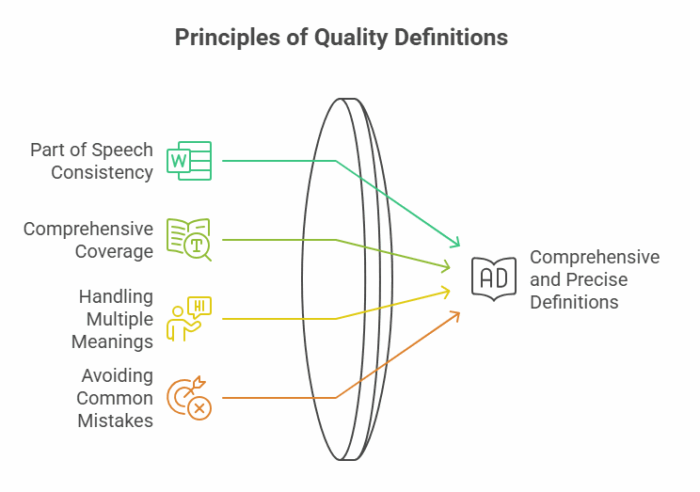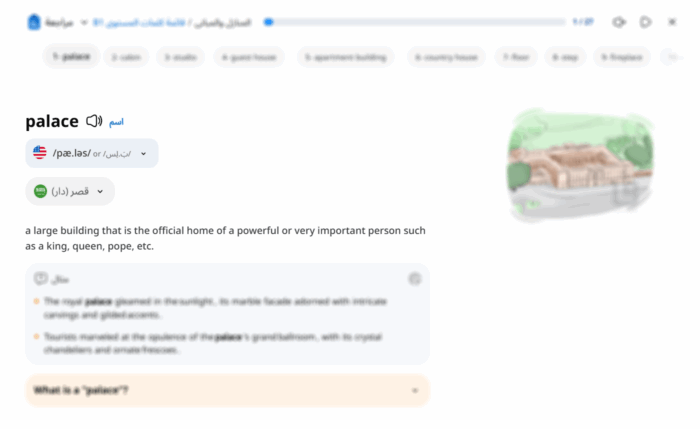At LanGeek, we are dedicated to providing accurate, clear, and reliable definitions and translations to help language learners understand and use words effectively. Our approach is rooted in classic lexicography standards, ensuring precision and care in every definition and translation. This guide explains how we create definitions, handle translations, and maintain quality, while also addressing the challenges we face, our team structure, and the importance of user feedback.
1. Our Approach to Definitions
LanGeek’s definitions are designed to be comprehensive, accessible, and precise. We follow these key principles to ensure quality:
Part of Speech Consistency
-
Every definition matches the part of speech (POS) of the word being defined. For example:
-
If the word is a noun, the definition is a noun phrase or clause.
-
Example: The noun “happiness” is defined as “the feeling of being happy,” maintaining the noun structure.
-
-
This ensures learners understand how the word functions in context.
Comprehensive Coverage
-
Our definitions cover all aspects of a word’s meaning, avoiding vagueness or ambiguity.
-
We aim to provide a complete understanding of the concept the word represents.
-
Example: The word “bank” is defined as “a financial institution where people deposit and withdraw money,” rather than a vague “place to store money.”
-
Handling Multiple Meanings
-
Words with multiple meanings are carefully categorized and separated based on semantic and syntactic behavior and context.
-
Example: The word “make” has 32 senses, such as:
-
“To create” (e.g., “make a cake”).
-
“To cause” (e.g., “make someone happy”).
-
-
Each sense is clearly defined to help learners grasp its unique usage.
-
Avoiding Common Mistakes
-
We carefully review definitions to prevent errors such as:
-
Circular definitions (e.g., defining “happy” as “feeling happiness”).
-
Redundancy or unnecessary repetition.
-
-
Our team ensures definitions are original, precise, and informative.

2. Translation Challenges and Strategies
Translating words across languages presents unique challenges, especially with cultural nuances, figurative language, and conceptual gaps. Here’s how we address them:
Matching Meanings Across Languages
-
Aligning each meaning of a word in one language with the correct meaning in another is critical.
-
We analyze context, usage, and cultural nuances to ensure accuracy.
-
Example: The English word “break” has multiple meanings (e.g., “to shatter” or “to rest”). Each is matched to the appropriate translation in the target language.
-
Dealing with Conceptual Gaps
Some concepts lack direct equivalents in other languages. We use strategies like:
-
Circumlocution: Describing the concept in detail.
-
Adapting related terms: Finding functional equivalents.
-
Example: The English word “privacy” (the state of being free from public attention or intrusion) has no direct equivalent in some languages, such as Japanese. We might translate it as “個人的な空間” (kojinteki na kūkan, meaning “personal space”) with an explanation to convey the concept fully.
Translating Figurative Language
Idioms, metaphors, and proverbs are challenging. We focus on conveying the essence of the expression, not a literal translation, to preserve idiomatic meaning and cultural context.
-
Example: The English idiom “kick the bucket” (meaning “to die”) is translated to its equivalent idiomatic expression in other languages, not as a literal “kicking a bucket.”

3. Team Structure and Quality Control
LanGeek’s content is created and maintained by a dedicated team of content writers, supervisors, and language experts. Here’s how we ensure quality:
Content Creation and Review
-
Each definition is:
-
Written by a content writer.
-
Checked by a supervisor for accuracy and clarity.
-
-
The head of content conducts random checks to ensure adherence to our standards.
Handling Multiple Meanings
-
For words with multiple senses (e.g., “make” with 32 meanings), we use strict criteria based on:
-
Semantic factors (meaning).
-
Syntactic factors (usage in sentences).
-
Contextual factors (specific situations).
-
-
This ensures every sense is clearly defined and distinct.
Ensuring Consistency Across Languages
-
With multiple language experts involved, consistency is maintained through:
-
A supervising lexicographer who checks definitions and translations against our standards.
-
Allowing some individual writing style, as long as it aligns with our criteria.
-
4. Translation Levels and User Feedback
LanGeek employs a multi-level translation strategy to handle different languages and word frequencies:
Translation Levels
-
Computer-Made Translations: Used for less popular languages or less common words.
-
Assisted Computer Translations: A language expert explains the word’s meaning to guide the translation.
-
Human-Written Translations: Direct translations by language experts for accuracy and nuance.
User Feedback
-
User feedback is essential for improving translation quality.
-
Currently, users can send individual messages to report issues.
-
We are developing a simplified feedback system that allows users to:
-
Submit suggestions directly where they see problems.
-
Contribute to refining our content.
-
5. Special Considerations for Different Languages
Translating for languages with different grammatical structures or writing systems (e.g., tonal languages like Mandarin or right-to-left scripts like Arabic) requires special attention. Our approach includes:
Explanations Over Direct Equivalents
-
For languages with significant structural differences, we prioritize:
-
Providing an explanation of what the word means.
-
Avoiding forced direct translations that may lose meaning.
-
-
This ensures the concept is accurately conveyed, even when a direct equivalent doesn’t exist.
Cultural and Contextual Sensitivity
-
We consider cultural and linguistic nuances to ensure translations are:
-
Accurate.
-
Culturally appropriate.
-
6. Resources and References
LanGeek consults multiple references to inform our definitions and translations, including:
-
Dictionaries.
-
Language corpora.
-
Academic guidelines. Each content expert selects the most appropriate approach to write original definitions that meet LanGeek’s standards while leveraging the strengths of various resources.
7. Encouraging User Engagement
User feedback is invaluable to us. We encourage users to:
-
Report errors or suggest improvements in definitions and translations.
-
Contribute to refining our content through our upcoming simplified feedback system.
Your input helps us maintain the highest standards and ensures LanGeek remains a trusted resource for language learners worldwide.
8. LanGeek’s Commitment to Quality
At LanGeek, we are committed to providing accurate, clear, and reliable definitions and translations. Our meticulous approach, combined with a dedication to continuous improvement through user feedback, ensures our content remains a valuable tool for learners navigating the complexities of language.

